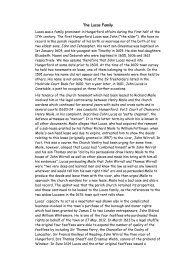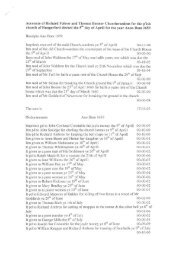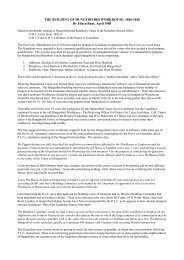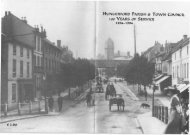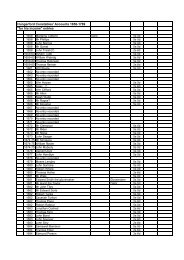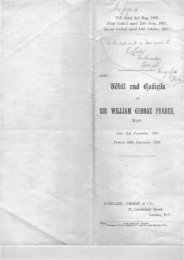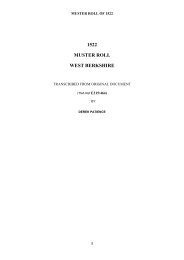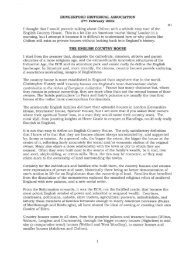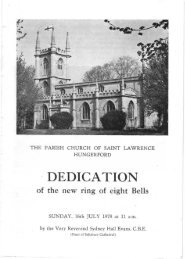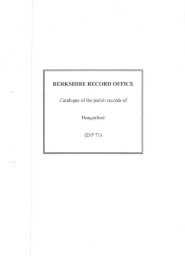Jethro Tull I, II, and III - Hungerford Virtual Museum
Jethro Tull I, II, and III - Hungerford Virtual Museum
Jethro Tull I, II, and III - Hungerford Virtual Museum
Create successful ePaper yourself
Turn your PDF publications into a flip-book with our unique Google optimized e-Paper software.
^<br />
<strong>Jethro</strong> <strong>Tull</strong> I, <strong>II</strong>, <strong>and</strong> <strong>II</strong>I<br />
By NORMAN HIDDEN<br />
Abstract<br />
Although <strong>Jethro</strong> <strong>Tull</strong> has been recognized as an important innovatory figure in agricultural methods in<br />
the eighteenth century, little has been written concerning his origins <strong>and</strong> social background; <strong>and</strong> much of<br />
that is either vague or inexact. From genealogical <strong>and</strong> other research, new information is provided<br />
concerning the family background of <strong>Jethro</strong> <strong>Tull</strong>. In particular the three <strong>Jethro</strong> <strong>Tull</strong>s who overlapped in<br />
time <strong>and</strong> place (especially with regard to Prosperous Farm) are distinguished. Some revision is suggested<br />
in the date of <strong>Tull</strong>'s commencement at Prosperous Farm <strong>and</strong> of his journey to the continental vineyards.<br />
This <strong>and</strong> other additional background information throws light both on <strong>Tull</strong>'s personality <strong>and</strong> behaviour<br />
<strong>and</strong> on his need to innovate in order to convert Prosperous from sheepdown to arable.<br />
ALTHOUGH <strong>Jethro</strong> <strong>Tull</strong> the agriculturist<br />
was one of the great innovatory<br />
figures of the early eighteenth century,<br />
his origins, social background, <strong>and</strong><br />
many other aspects of his life have<br />
remained obscure. Works concerning <strong>Tull</strong><br />
have, quite naturally, concerned themselves<br />
primarily with his theories <strong>and</strong> practice;<br />
his ancestral <strong>and</strong> social origins have<br />
been concealed from his biographers, <strong>and</strong><br />
several events in his life which clearly have<br />
a bearing on the development of his practice<br />
<strong>and</strong> theories or on their relationship to<br />
each other have been ascribed to speculative<br />
rather than exact or proven dates.<br />
The fact is that the sources of information<br />
concerning <strong>Tull</strong>'s life are skimpy, <strong>and</strong> later<br />
accounts tend to follow earlier ones blindly<br />
<strong>and</strong> without necessary verificatiorf<br />
The earliest information we have is to<br />
be found in scattered remarks made by<br />
<strong>Tull</strong> himself in the various editions of<br />
his Horse-Hoeing Husb<strong>and</strong>ry. The object of<br />
many of his autobiographical remarks was<br />
almost wholly defensive, to rebut what he<br />
considered unfair attacks upon his farming<br />
practice. Used in this controversial context<br />
his autobiographical remarks are inevitably<br />
limited, revealing only that which he<br />
wished to reveal to the outside world <strong>and</strong><br />
then simply to refute a specific inaccuracy<br />
by one or other of his opponents. Nevertheless<br />
these occasional sentences in the<br />
text or in the footnotes of his work are<br />
the major primary material which provides<br />
Ag Hist Rev, 37, I, pp 26-35 26<br />
US with some details of his personal life<br />
<strong>and</strong> background, scanty though they are.<br />
These scattered notes <strong>and</strong> addenda were<br />
collated in William Cobbett's edition of<br />
1829, making it the most convenient edition<br />
to use overall.'<br />
The next source of information is to be<br />
found in an article written by one DY of<br />
<strong>Hungerford</strong> <strong>and</strong> published in the Gentleman's<br />
Magazine in 1764. The identity of<br />
D Y is not known, but he claims to have<br />
been 'personally acquainted' with <strong>Tull</strong> <strong>and</strong>,<br />
if the ascription 'of <strong>Hungerford</strong>' is true,<br />
he lived in the same parish <strong>and</strong> was therefore<br />
in a good position to know something<br />
of a personal kind concerning the subject<br />
of his article. Nevertheless, there are many<br />
details which he takes on trust from the<br />
scattered autobiographical details given by<br />
<strong>Tull</strong> himself. 2<br />
The third source of material for <strong>Tull</strong>'s<br />
life is Earl Cathcart's article in the Journal<br />
of the Royal Agricultural Society, 1891. This<br />
article bases itself on the diary of Cathcart's<br />
ancestor, an earlier Earl Cathcart who<br />
befriended <strong>and</strong> encouraged <strong>Tull</strong> during his<br />
lifetime. 3<br />
On these three sources - <strong>Tull</strong> himself,<br />
D Y of <strong>Hungerford</strong>, <strong>and</strong> Earl Cathcart<br />
- all subsequent biographies have based<br />
themselves, adding thereto little of consequence.<br />
The Dictionary of National Biogra-<br />
' <strong>Jethro</strong> <strong>Tull</strong>, The Horse-Hoeing Husb<strong>and</strong>ry, ed, Cobbett 1829.<br />
2 D Y, The Gentleman's Magazine, 1764, pp 522—526.<br />
1 Earl Cathcart, '<strong>Jethro</strong> Tul'l', JRAS, 3rd series, <strong>II</strong>, 1891.
.•thods in<br />
much of<br />
provided<br />
lapped in<br />
• uggested<br />
meyards.<br />
«nal life<br />
icy are.<br />
ia were<br />
tion of<br />
int edi-<br />
is to be<br />
DY of<br />
Gent/entity<br />
of<br />
to have<br />
ull <strong>and</strong>,<br />
is true,<br />
is therenething<br />
subject<br />
re many<br />
•o«i the<br />
;. .1 by<br />
• r <strong>Tull</strong>'s<br />
.• Journal<br />
•)i. This<br />
ithcart's<br />
irt who<br />
iring his<br />
himself,<br />
Cathcart<br />
•e based<br />
if conse-<br />
/ Biogra-<br />
tt 1829.<br />
phy contains an article which summarizes<br />
the information up to the date of its publication.<br />
In 1973, Dr G E Fussell wrote a<br />
volume <strong>Jethro</strong> <strong>Tull</strong>: his influence on mechanised<br />
Agriculture, in which he devoted a<br />
chapter to <strong>Tull</strong>'s biography, <strong>and</strong> in it he<br />
reveals some of the many uncertainties <strong>and</strong><br />
confusions which have existed <strong>and</strong> which<br />
he himself is unable to explain away. 4<br />
Some of the main confusions <strong>and</strong> uncertainties<br />
concern <strong>Tull</strong>'s parentage, his<br />
father's place of origin, his social <strong>and</strong><br />
financial st<strong>and</strong>ing; the date <strong>and</strong> place at<br />
which <strong>Tull</strong> himself commenced farming;<br />
the date at which he removed from Howberry<br />
to Prosperous Farm in Shalbourne;<br />
the true date of his extensive tour abroad<br />
to Montpellier <strong>and</strong> the French vineyards;<br />
<strong>and</strong> even the exact date <strong>and</strong> place of his<br />
death.<br />
I<br />
The Dictionary of National Biography states<br />
that <strong>Jethro</strong> <strong>Tull</strong> was born at Basildon in<br />
Berkshire in the year 1674, the son of<br />
<strong>Jethro</strong> <strong>and</strong> Dorothy <strong>Tull</strong>. And indeed there<br />
is an entry in the Basildon parish register<br />
recording a baptism on 30 March 1674<br />
which confirms this. After this date, however,<br />
there are no further entries in the<br />
Basildon register which might indicate that<br />
the family were settled in the parish <strong>and</strong><br />
thus the probability that young <strong>Jethro</strong><br />
spent his boyhood there.<br />
G E Fussell in his life of <strong>Jethro</strong> <strong>Tull</strong> is<br />
aware of this difficulty. 'How the family<br />
became connected with Basildon was not<br />
known in 1889' (presumably the date of<br />
publication of the DNB article), he writes. 5<br />
In fact, however, the connection with<br />
Basildon is explicable, <strong>and</strong> in what is the<br />
most likely way. It was in Basildon in June<br />
1672 that <strong>Jethro</strong> <strong>Tull</strong> married Dorothy<br />
Buckeridge. The Buckeridges were a Basil-<br />
4 G E Fussell, Jrthro Tnll: his influence on mechanized Agriculture,<br />
Reading, 1973.<br />
' Fussell, op fit p 0.<br />
JETHRO TULL, I, <strong>II</strong> AND <strong>II</strong>I<br />
don family <strong>and</strong> Basildon was the bride's<br />
parish. 6 A search of neighbouring parish<br />
registers reveals that <strong>Jethro</strong> <strong>and</strong> Dorothy<br />
had a daughter, named Dorothy, baptized<br />
in the parish of Bradfield on 5 February<br />
1676. Bradfield is the parish immediately<br />
south of Basildon; <strong>and</strong> this rather than<br />
Basildon, was the home of the <strong>Tull</strong>s. 7 The<br />
next baptism we have for a child of <strong>Jethro</strong><br />
<strong>and</strong> Dorothy <strong>Tull</strong>, however, is in a parish<br />
as far removed in Berkshire as it was<br />
possible to be. This was the baptism of<br />
Elizabeth, daughter of <strong>Jethro</strong> <strong>and</strong> Dorothy<br />
<strong>Tull</strong>, at Shalbourne 14 April 1679."<br />
Shalbourne was the site of Prosperous<br />
Farm; it lies at the extreme southwest of<br />
the parish of <strong>Hungerford</strong> <strong>and</strong> is partly<br />
in Wiltshire <strong>and</strong> partly in Berkshire. The<br />
question arises as to what was <strong>Tull</strong> senior's<br />
connection with Shalbourne at this date,<br />
<strong>and</strong> whether he was farming Prosperous<br />
Farm there. Indeed Fussell asks whether<br />
the connection may not have been even<br />
earlier, pointing out that the 1664-6 (sic)<br />
Visitation of Berkshire mentions a <strong>Jethro</strong><br />
<strong>Tull</strong> of Shalbourne 'who married Mary,<br />
daughter of one Farmer of Cholsey, whose<br />
Christian name is not stated'. 9 But it is<br />
stated, revealing that Fussell had not consulted<br />
his primary sources. The Visitation<br />
shows that <strong>Jethro</strong> <strong>Tull</strong> of Shalbourne was<br />
the son of Giles <strong>Tull</strong> of Midgham, Berks;<br />
that he had an elder brother James of<br />
Bradfield, Berks, <strong>and</strong> a younger brother<br />
Giles; <strong>and</strong> that he married Mary daughter<br />
of Jeffery Farmer of Cholsey, Berks. That<br />
these facts are correct is certified by <strong>Jethro</strong><br />
<strong>Tull</strong> himself. to<br />
The Victoria County History of Berkshire<br />
confirms this marriage, indirectly, by its<br />
entry concerning the advowson of the<br />
church of Cholsey, possession of which<br />
was shared in 1682 by Mary, 'daughter of<br />
* Berks RO, Basildon Parish Register 3 June 1672.<br />
7<br />
Berks RO, Bradfield Parish Register 18 Jan 1635, I Jan 1644 etc.<br />
8<br />
Wilts RO. 534/1 Shalbourne Parish Register 14 April 1679.<br />
"* Fusscll, op cit p 6.<br />
10<br />
Visitation of Berkshire 1665/6, Harleian Soc, LVI, p 297.
28 THE AGRICULTURAL HISTORY REVIEW<br />
Geoffrey Farmer <strong>and</strong> wife ofjethro lull'."<br />
The possible awkwardness of a daughter<br />
born to <strong>Jethro</strong> <strong>and</strong> Dorothy <strong>Tull</strong> in 1679<br />
<strong>and</strong> a <strong>Jethro</strong> <strong>Tull</strong> with a wife Mary in 1682<br />
seems to have raised no queries from the<br />
biographers of the son ofjethro <strong>and</strong> Dorothy.<br />
One would expfect them to have<br />
searched for a burial entry between those<br />
years which would confirm the death of<br />
Dorothy. In such searching they might<br />
have discovered, but obviously did not,<br />
that there exists a foot of fine in 1678, in<br />
which <strong>Jethro</strong> <strong>Tull</strong> <strong>and</strong> his wife Mary sold<br />
l<strong>and</strong> in <strong>Hungerford</strong>, Inkpen <strong>and</strong> Shalbourne<br />
to Sir William Jones, Attorney<br />
General. 12 Only two conclusions seem to<br />
present themselves: either <strong>Jethro</strong> <strong>Tull</strong> was<br />
a bigamist or there were two <strong>Jethro</strong> Tu'lls,<br />
both associated with Shalbourne. Still<br />
further search uncovers a case in Chancery<br />
in 1678 in which <strong>Jethro</strong> <strong>Tull</strong> was a defendant<br />
in a suit brought by Frances Farmer<br />
widow of Jeffery Farmer, in which a copyhold<br />
in Cholsey was involved <strong>and</strong> concerning<br />
the administration of the estate of the<br />
late Jeffery Farmer.' 3<br />
Depositions in yet another suit claim<br />
that in January 1674 an agreement or treaty<br />
was made between Griffith Jones of Radnorshire,<br />
Wales, <strong>and</strong> <strong>Jethro</strong> <strong>Tull</strong> of Cholsey,<br />
Berks, gent, for a marriage to be<br />
solemnized between Jones's son <strong>and</strong> Elizabeth<br />
Goddard, daughter <strong>and</strong> heir of Vincent<br />
Goddard, late of Howberry, Oxon.<br />
Esq. deceased, <strong>Jethro</strong> <strong>Tull</strong> having married<br />
Mary, Elizabeth's mother.' 4<br />
Clearly, if there are two <strong>Jethro</strong> <strong>Tull</strong>s at<br />
this time, one married to Dorothy Buckeridge<br />
<strong>and</strong> one to Mary Farmer, both having<br />
associations with Howberry as well as with<br />
Shalbourne, it becomes difficult to be certain<br />
of the exact origins ofjethro <strong>Tull</strong> the<br />
agriculturist. And if the <strong>Jethro</strong> <strong>Tull</strong> of<br />
Cholsey married Mary Farmer how is it<br />
" Victoria County History, Berks, <strong>II</strong>I, p 302.<br />
" Public Record Office: CP25/2/29-3O Charles <strong>II</strong>, Hilary term.<br />
" PRO, C22/249/S.<br />
'" PRO, €5/169/38.<br />
he is now revealed as married to Mary<br />
Goddard? The answer to this is fortunately<br />
simple. Mary Farmer first married Vincent<br />
Goddard; <strong>and</strong> subsequently, following<br />
Vincent's death,' 5 she became the wife of<br />
<strong>Jethro</strong> <strong>Tull</strong>. For the purpose of this article<br />
it may now be convenient to label <strong>Jethro</strong><br />
<strong>Tull</strong> who married Mary Goddard nee<br />
Farmer as <strong>Jethro</strong> <strong>Tull</strong> I <strong>and</strong> <strong>Jethro</strong> <strong>Tull</strong><br />
who married Dorothy Buckeridge <strong>Jethro</strong><br />
<strong>Tull</strong> <strong>II</strong>. <strong>Jethro</strong> <strong>Tull</strong> the agriculturist will<br />
then be <strong>Jethro</strong> <strong>Tull</strong> <strong>II</strong>I.<br />
<strong>II</strong><br />
Which of the <strong>Jethro</strong>s I <strong>and</strong> <strong>II</strong> was the <strong>Jethro</strong><br />
<strong>Tull</strong> who was holding Prosperous Farm in<br />
the years prior to its occupation by the<br />
agriculturist <strong>Jethro</strong> <strong>Tull</strong> <strong>II</strong>I? Deeds in the<br />
Wiltshire Record Office connect <strong>Jethro</strong><br />
<strong>Tull</strong> <strong>II</strong> <strong>and</strong> his wife Dorothy with Prosperous<br />
Farm in 1686.' 6 Deeds formerly in the<br />
Berkshire Record Office but now in the<br />
Wiltshire Record Office relate to a <strong>Jethro</strong><br />
<strong>Tull</strong> in the area in 1674 <strong>and</strong> earlier.' 7 The<br />
biographers ofjethro <strong>Tull</strong> the agriculturist<br />
(<strong>Jethro</strong> <strong>II</strong>I) have simply merged the two<br />
men into one. They have not only missed<br />
details in local parish registers (more<br />
accessible nowadays than in theirs), but<br />
they seem to have been unaware of the<br />
rich source of material in the records of<br />
the court of Chancery which concern<br />
<strong>Jethro</strong> <strong>Tull</strong> I, <strong>II</strong>, <strong>and</strong> <strong>II</strong>I.<br />
Deposing in a Chancery suit which<br />
occurred in 1676, <strong>Jethro</strong> <strong>Tull</strong> !• describes<br />
himself as of Cholsey, Berks, gent, aged<br />
60 or thereabouts. He had been employed<br />
by Thomas Hussey senior in receiving <strong>and</strong><br />
collecting the rents <strong>and</strong> profits of Hussey's<br />
estates in Hampshire, Berkshire <strong>and</strong><br />
Wiltshire for nearly twenty years before<br />
the latter's death, (which occurred in 1657).<br />
He continued in this capacity during the<br />
lifetime of Hussey's son, Thomas Hussey<br />
'•' PRO, PCC Will, Vincent Goddard 1657.<br />
"' Quoted by Fussell, op cit, p 21.<br />
17 Wilts RO, 1883/127.<br />
junior (<br />
his heii<br />
relinqui<br />
tees hea<br />
employ<br />
until ab<br />
In tl<br />
<strong>Jethro</strong><br />
elemeni<br />
master<br />
was re<br />
bequeai<br />
Hussey<br />
Busine;<br />
lease o<br />
<strong>Tull</strong> 01<br />
the cen<br />
the net<br />
its mai<br />
The<br />
the am<br />
its incc<br />
plain,<br />
sey sei<br />
death<br />
sums c<br />
otherv<br />
£1000<br />
<strong>Jethro</strong>'<br />
trustee<br />
estate<br />
<strong>and</strong> lej<br />
or call<br />
leases,<br />
to pre<br />
take u<br />
their t<br />
payrm<br />
legacit<br />
the tr<br />
friend<br />
invoh<br />
as len<br />
• PRO,<br />
• ;/>„/.
Mary<br />
lately<br />
ncent<br />
iwing<br />
ife of<br />
irticle<br />
ethro<br />
1 nee<br />
<strong>Tull</strong><br />
ethro<br />
: will<br />
rm in<br />
y the<br />
n the<br />
ethro<br />
>sperin<br />
the<br />
n the<br />
ethro<br />
1 The<br />
turist<br />
• two<br />
lissed<br />
more<br />
, but<br />
• f the<br />
ds of<br />
ncern<br />
pursued him from Wales to Cholsey where<br />
he found only his wife Mary. Mrs <strong>Tull</strong><br />
told the wea'ry seeker that 'her husb<strong>and</strong><br />
had not been there once for a long time<br />
before, neither could she tell him where to<br />
send unto him'. Another deponent in the<br />
same suit asserted that 'it is commonly<br />
reported that <strong>Tull</strong> is far indebted <strong>and</strong><br />
engaged deeply to many creditors that he<br />
hath by reason of his own debts <strong>and</strong> suretyships<br />
for others passed <strong>and</strong> conveyed all<br />
his estate to some trustees under colour of<br />
bargains or privately that thereby he might<br />
avoid the payment of his debts ... it<br />
is also commonly reported that he doth<br />
abscond <strong>and</strong> hide himself in some privileged<br />
places (or places said to be privileged)<br />
from arrest lest he should be arrested'. 23<br />
In 1688/9 <strong>Tull</strong> was in Midhurst, Sussex 24<br />
<strong>and</strong> there he died, being buried on 23<br />
September 1691. The burial record is taken<br />
from a typed transcript made by W H<br />
Challen <strong>and</strong>, typical of the confusion<br />
which surrounds <strong>and</strong> clings to the name<br />
<strong>Jethro</strong> <strong>Tull</strong>, it has been mistranscribed as<br />
<strong>Jethro</strong> Full! 25<br />
<strong>II</strong><br />
His busy, active life may seem to have<br />
ended in failure. But he never gave up his<br />
ambition to establish a <strong>Tull</strong> estate in that<br />
hilly corner of Berkshire adjoining the<br />
l<strong>and</strong>s of his former employers. Somehow<br />
he contrived to squeeze out of his losses a<br />
farm in the area which he boldly called<br />
(or which by amazing chance was called)<br />
Prosperous. He was able to do this by<br />
transferring the farm to <strong>Jethro</strong> <strong>Tull</strong> <strong>II</strong><br />
before his creditors could get at it. A letter<br />
written by <strong>Jethro</strong> I to <strong>Jethro</strong> <strong>II</strong> <strong>and</strong> dated<br />
25 May 1680 says 'I owe you for my own<br />
dyett [diet] <strong>and</strong> for my horse ever since you<br />
came to Prosperouse'. 26 The transaction<br />
" PRO, €22/465/8.<br />
"PRO, 024/1123.<br />
^ W H Challen, Typescript, vol X<strong>II</strong>, Guildhall Library, London.<br />
"' 1'UO, 022/920/24.<br />
THE AGRICULTURAL HISTORY REVIEW<br />
seems to substantiate the deposition which<br />
referred to his use of'trustees' to save some<br />
at least of his estate from the <strong>Tull</strong>/Hussey<br />
creditors. The letter (particularly when<br />
linked with the baptism in Shalbourne in<br />
1679 of <strong>Jethro</strong> <strong>Tull</strong> <strong>II</strong>'s daughter Elizabeth)<br />
makes it clear that <strong>Jethro</strong> <strong>II</strong> had settled into<br />
the property; <strong>and</strong> the acknowledgement by<br />
<strong>Jethro</strong> I of his debt for board <strong>and</strong> lodging<br />
suggests that he had granted the estate to<br />
<strong>Jethro</strong> <strong>II</strong> more fully than if he had<br />
appointed him as a nominal trustee only.<br />
The use of the name Prosperous at this<br />
early date, long before the agricultural<br />
innovations of <strong>Jethro</strong> <strong>II</strong>I, shows that the<br />
farm's name did not derive (as some may<br />
think) from the youngest <strong>Tull</strong>'s success<br />
but was already in existence. The earliest<br />
use of the name I have been able to find<br />
is in a document of 1677 when <strong>Jethro</strong> <strong>Tull</strong><br />
I is described as of Prospers farm. 27 It is<br />
certain that the farm, as such, did not exist<br />
before the time of <strong>Jethro</strong> <strong>Tull</strong> I. He seems<br />
to have created it from bits <strong>and</strong> pieces of<br />
l<strong>and</strong> lying in <strong>and</strong> between other farms in<br />
the area, such as Helmes, Anvilles, Old<br />
Anvilles, <strong>and</strong> Helmes Heath. The latter<br />
was an area which had been subject to<br />
constant enclosures <strong>and</strong> one must suspect<br />
that Prosperous may have in part owed its<br />
origin to one or other of these enclosures. 28<br />
<strong>Jethro</strong> <strong>II</strong>I says that the farm was 'cut out<br />
of the skirts of others <strong>and</strong> a great part of<br />
the l<strong>and</strong> was formerly a sheep down'; <strong>and</strong><br />
elsewhere in his book he says that Prosperous<br />
was first made into a farm 'about<br />
seventy years ago', a statement that takes<br />
it back to the time of <strong>Jethro</strong> I. 29<br />
Since <strong>Jethro</strong> <strong>Tull</strong> I granted Prosperous<br />
Farm to <strong>Jethro</strong> <strong>Tull</strong> <strong>II</strong>, how close was their<br />
relationship? Although all previous writers<br />
have confused (or ignored ) the relationship,<br />
usually considering <strong>Jethro</strong> I <strong>and</strong><br />
<strong>Jethro</strong> <strong>II</strong> as one <strong>and</strong> the same man, the<br />
answer is quite simple. <strong>Jethro</strong> <strong>Tull</strong> I was<br />
" Wilts RO, 1883/127.<br />
" Berks RO, H/Ms.<br />
'" <strong>Tull</strong>, op cil. pp 214. 386.<br />
the<br />
Jan<br />
Th<br />
nei<br />
m;<br />
wl<br />
is<br />
ag<br />
in<br />
in<br />
or<br />
an<br />
wi<br />
P<<br />
('•<br />
an<br />
at<br />
•A<br />
b.<br />
(I!<br />
bi<br />
it<br />
J-<<br />
R<br />
fi<br />
d.<br />
n<br />
h<br />
P<br />
P
ich<br />
me<br />
sey<br />
len<br />
in<br />
th)<br />
no<br />
by<br />
ing<br />
to<br />
lad<br />
y-<br />
:his<br />
iral<br />
the<br />
test<br />
ind<br />
r is<br />
>dst<br />
•ms<br />
, of<br />
, in<br />
31d<br />
tter<br />
to<br />
>ect<br />
iits<br />
.•s. 2S<br />
out<br />
: of<br />
<strong>and</strong><br />
"'--<br />
1 v, t<br />
ikes<br />
ous<br />
iieir<br />
ters<br />
on<strong>and</strong><br />
the<br />
was<br />
the brother of James <strong>Tull</strong> of Bradfield, <strong>and</strong><br />
James was the father of <strong>Jethro</strong> <strong>Tull</strong> <strong>II</strong>.'°<br />
The two <strong>Jethro</strong>s, therefore, were uncle <strong>and</strong><br />
nephew. As it was the uncle who had<br />
married Mary Goddard <strong>and</strong> the nephew<br />
who had married Dorothy Buckeridge it<br />
is clear that the father of <strong>Jethro</strong> <strong>Tull</strong> the<br />
agriculturist was <strong>Jethro</strong> <strong>II</strong>.<br />
The family was evidently very close <strong>and</strong><br />
in a deposition in 1698 young <strong>Jethro</strong> <strong>Tull</strong><br />
<strong>II</strong>I, then aged 24 <strong>and</strong> at Grays Inn, testifies<br />
on behalf of his father. 31 Also deposing is<br />
another James <strong>Tull</strong>, brother of <strong>Jethro</strong> <strong>II</strong>,<br />
who states that his uncle [<strong>Jethro</strong> I] 'did<br />
possess <strong>and</strong> live in a farm called Prosperent<br />
(?) farm in or near Shalborne or Bagshot<br />
<strong>and</strong> worth about £100 p.a., part freehold<br />
<strong>and</strong> part leasehold, <strong>and</strong> another farm of<br />
about £30 p.a. in or near Bagshot or Shalborne,<br />
Berks for about seven or eight years<br />
of his said uncle's life', <strong>and</strong> he believed his<br />
brother [<strong>Jethro</strong> <strong>II</strong>] had received rent from<br />
it ever since <strong>Jethro</strong> I's death. The last time<br />
James <strong>Tull</strong> had seen his uncle was at the<br />
Rose <strong>and</strong> Crown in the precinct of Whitefriars<br />
in London not long before the latter's<br />
death when his uncle told him that he had<br />
made over certain farms <strong>and</strong> premises to<br />
his nephew [<strong>Jethro</strong> <strong>II</strong>] in trust for the<br />
payment of his debts <strong>and</strong> seemed to complain<br />
that <strong>Jethro</strong> <strong>II</strong> had paid little of them.<br />
<strong>Jethro</strong> <strong>II</strong> continued to hold his estate at<br />
Howberry throughout these crises. In<br />
1691, about four years after he had<br />
acquired Howberry from Edmund Gregory<br />
(an associate of <strong>Jethro</strong> I), he was<br />
involved in a law suit concerning the rent<br />
charges <strong>and</strong> taxes on the property. 12 This<br />
is the first sign of his growing financial<br />
problems. It is also the year in which his<br />
uncle <strong>Jethro</strong> I died. Sheltered hitherto from<br />
legal <strong>and</strong> financial problems by his uncle's<br />
ingenuity <strong>and</strong> wide-ranging contacts,<br />
<strong>Jethro</strong> <strong>II</strong> now began to be plagued by<br />
' TOO. €22/920/24.<br />
,hi,l.<br />
1 TOO. €22/296/3.<br />
JETHRO TULL, I, <strong>II</strong> AND <strong>II</strong>I<br />
lawsuits which had reached a peak in 1695<br />
<strong>and</strong> in which his family affairs were<br />
exposed in all their shakiness. 33 The financial<br />
problems which brought down <strong>Jethro</strong><br />
I were now close to bringing down <strong>Jethro</strong><br />
<strong>II</strong> too. This was during those years when<br />
his son <strong>Jethro</strong> <strong>II</strong>I was leading, successively,<br />
the life of an undergraduate at Oxford, a<br />
student of Grays Inn, <strong>and</strong> a young man<br />
about town in London. The fall of his<br />
great uncle <strong>Jethro</strong> I would have been<br />
ancient history but the effects of it were<br />
continuing <strong>and</strong> the financial predicament<br />
in which this involved his own family<br />
cannot have been but embarrassing, perhaps<br />
distressing, to a young man in a<br />
family so closely knit that the name <strong>Jethro</strong><br />
(meaning in Hebrew, ironically, 'abundance')<br />
was passed down for three successive<br />
generations. The sudden reversal of the<br />
<strong>Tull</strong> family fortunes <strong>and</strong> its continuing<br />
reverberations may be the circumstances<br />
to which <strong>Jethro</strong> <strong>II</strong>I referred when he wrote<br />
that 'accident, not choice, made me a<br />
farmer, or rather many unforeseen accidents'.<br />
34<br />
In 1697 <strong>Jethro</strong> <strong>Tull</strong> <strong>II</strong> explains that he,<br />
his father James <strong>Tull</strong>, <strong>and</strong> his uncle <strong>Jethro</strong><br />
I had had 'many dealings together <strong>and</strong><br />
[had] been bound for one another in several<br />
bonds'. 35 When James died, he appointed<br />
both <strong>Jethro</strong> I <strong>and</strong> <strong>Jethro</strong> <strong>II</strong> as his executors.<br />
But it was <strong>Jethro</strong> I who undertook the<br />
administration, <strong>Jethro</strong> <strong>II</strong> then 'being a<br />
young man <strong>and</strong> but little acquainted with<br />
business'. <strong>Jethro</strong> <strong>II</strong> states that his uncle had<br />
satisfied all the debts owed by James <strong>and</strong><br />
discharged all his bonds. He claims that<br />
the suits brought against him now were<br />
merely vexatious <strong>and</strong> that his time <strong>and</strong><br />
money were being exhausted by his 'being<br />
forced to defend himself against a multiplicity<br />
of suits <strong>and</strong> be put to the charges<br />
of bringing his evidences often times to<br />
11 PRO, 022/920/23.<br />
14 <strong>Tull</strong>. dp cit, p xi.<br />
" PRO, 010/353/52.
the same matter at law'. A year later there<br />
were no less than four suits pending which<br />
involved <strong>Jethro</strong> <strong>II</strong>. 36<br />
Among the allegations made in the case<br />
in 1697 was one that <strong>Jethro</strong> <strong>II</strong> had undertaken<br />
to 'pay all his uncle's [outst<strong>and</strong>ing]<br />
debts <strong>and</strong> on that condition got all the<br />
estate from his said uncle in his lifetime'.<br />
THE AGRICULTURAL HISTORY REVIEW<br />
Ill<br />
Biographers of <strong>Jethro</strong> <strong>Tull</strong> <strong>II</strong>I seem to have<br />
been unable to discover the date of his<br />
father's death. The actual date is of some<br />
moment in establishing when <strong>Jethro</strong> <strong>II</strong>I<br />
may have inherited his father's estate in<br />
Howberry (<strong>and</strong> also the freehold portion<br />
of the estate in Shalbourne). It is possible<br />
that the estate, or a portion of itt was made<br />
over to him <strong>and</strong> his wife upon his marriage<br />
in 1699. The leasehold portion of the Shalbourne<br />
estate had been made over to him<br />
in iyo4. 37 This transfer (a lease having been<br />
previously held by his father dated 1686)<br />
has led some biographers to assume that it<br />
was in this year 1704 that the father died.<br />
This was not so: <strong>Jethro</strong> <strong>Tull</strong> <strong>II</strong> died in<br />
1713- 38<br />
Does the lease of 1704 mean that young<br />
<strong>Jethro</strong> began to farm Prosperous at that<br />
date while his father continued at Howberry<br />
until his death in 1713? The Dictionary<br />
of National Biography commences him<br />
at Prosperous in 1709, though for no given<br />
reason. No further reference has yet been<br />
found of <strong>Jethro</strong> <strong>II</strong> at Prosperous later than<br />
the 1686 lease; but there are various references<br />
to him in Howberry from 1688<br />
onwards, corresponding with the suggested<br />
date of his acquisition of the farm<br />
at Howberry.' 9 The new property there<br />
would certainly have taken up his time <strong>and</strong><br />
energies. It was quite natural, therefore,<br />
that from Michaelmas 1686 to September<br />
" PRO, C22/920/34-<br />
17 Quoted by Fussell, op cit, pp 21-22.<br />
'" PRO, Ci 1/075/2.<br />
H PRO, €22/296/3; €22/920/24; Cio/353/52.<br />
1691 Prosperous Farm should have been<br />
leased to a local tenant farmer named<br />
Smith, a lease which was then extended<br />
for at least another two years. 40<br />
It seems unlikely that the occupation of<br />
Prosperous Farm by <strong>Jethro</strong> <strong>Tull</strong> <strong>II</strong>I would<br />
have been later than the 1704 lease, <strong>and</strong><br />
his management of the farm might have<br />
been even earlier. If it is true that <strong>Jethro</strong><br />
began his agricultural experiments at Howberry<br />
it seems that they must have been<br />
carried out between 1699, the date of his<br />
marriage, <strong>and</strong> 1704 when he <strong>and</strong> his wife<br />
acquired the new lease at Shalbourne. If<br />
the experiments did indeed cause hostility<br />
in his father's main estate at Howberry,<br />
this could well have been a cause for the<br />
father to feel the need to remove the son<br />
to another area where he could begin<br />
afresh. On the other h<strong>and</strong> there is a local<br />
tradition that <strong>Tull</strong>'s seed drill was first used<br />
at Prosperous Farm. The claim was made<br />
by a later owner of the farm, Lt.-Col Wills,<br />
who showed the broadcaster-journalist<br />
Ralph Wightman the very pit or well into<br />
which, he claimed, the villagers had<br />
pushed the hated drill, having first smashed<br />
<strong>and</strong> broken it. 41<br />
There has been much speculation concerning<br />
the date of <strong>Jethro</strong> <strong>Tull</strong> Ill's journey<br />
to the Continent. Fussell gives April 1711<br />
as his date of departure, basing it on <strong>Tull</strong>'s<br />
own statement, '<strong>and</strong> he is most likely to<br />
be correct, although memory is apt to play<br />
a man false'. 42 The Dictionary of National<br />
Biography dates his departure similarly <strong>and</strong><br />
gives his return as in 17.14. 4J If either of<br />
these statements were correct, one would<br />
wonder at the baptism on 13 October 1713<br />
at Shalbourne of <strong>Tull</strong>'s daughter Sarah. 44<br />
However, a different set of dates which<br />
makes much more sense is thrown up<br />
by the information given in yet another<br />
Chancery case in which <strong>Jethro</strong> Ill's bro-<br />
40 PRO, Cio/353/52.<br />
41 Ralph Wightman, Rural Rides, 19S7, p!6.<br />
4 ~ Fussell, op cit, p 20.<br />
41 Dictionary of National Biography, article on <strong>Jethro</strong> <strong>Tull</strong>.<br />
44 Wilts RO, 534/1, Shalbourne Parish Register.
.ive been<br />
r named<br />
extended<br />
nation of<br />
<strong>II</strong> would<br />
ase, <strong>and</strong><br />
rht have<br />
it <strong>Jethro</strong><br />
at Howive<br />
been<br />
re of his<br />
his wife<br />
>urne. If<br />
hostility<br />
\ rry,<br />
for the<br />
the son<br />
.1 begin<br />
> a local<br />
irst used<br />
is made<br />
)1 Wills,<br />
lurnalist<br />
/ell into<br />
-•rs had<br />
mashed<br />
m conjourney<br />
ril 1711<br />
11 lull's<br />
kely to<br />
to play<br />
'onal<br />
rly <strong>and</strong><br />
ther of<br />
would<br />
er 1713<br />
-.rah. 44<br />
which<br />
\vn up<br />
mother<br />
's bro-<br />
ther-in-law states that <strong>Jethro</strong>, being seized<br />
of the Howberry estate in 1713 '<strong>and</strong> being<br />
in a very ill state of health was advised for<br />
recovery thereof to travel to Montpellier<br />
beyond the sea, which he accordingly did,<br />
but before he proceeded in his travel he<br />
made a letter of attorney empowering his<br />
wife Susannah to deal with his estates'. 45<br />
Both parties in the case agree that <strong>Jethro</strong><br />
set out for abroad at the beginning of the<br />
year 1713 [i.e. probably in April] <strong>and</strong> it is<br />
clear that he was out of the country before<br />
6 July when his wife made some sort of<br />
agreement about the letting of his Oxfordshire<br />
estates. Both parties agree that <strong>Jethro</strong><br />
returned in 1715.<br />
While he was abroad two events<br />
occurred which he may or may not have<br />
expected when he set off <strong>and</strong>, if his health<br />
was bad, may not have been informed<br />
about. One was the birth of his daughter<br />
Sarah. If <strong>Tull</strong> left the country in April 1713<br />
it is possible that he would not have known<br />
of his wife's pregnancy, which at the<br />
beginning of that month could have been<br />
of only a two-month period. The second<br />
event was the death of his father <strong>Jethro</strong> <strong>II</strong>.<br />
This was either in September 1713 or in<br />
March 1714: two different dates were provided<br />
by his in-law relatives in contention<br />
concerning his estate. 46 The Crowmarsh<br />
Gifford parish register, damaged by fire<br />
<strong>and</strong> incomplete, gives no record. Whatever<br />
the circumstances, a considerable burden<br />
must have fallen on <strong>Jethro</strong> Ill's wife Susannah.<br />
Susannah had married <strong>Jethro</strong> on 26<br />
October 1699, according to Earl<br />
Cathcart. 47 The place of marriage is not<br />
given by Cathcart, but Fussell states that<br />
'it may be assumed that it took place in<br />
London'. The assumption is made, presumably,<br />
to suit Fussell's account of the<br />
life of a young bachelor of means <strong>and</strong> status<br />
living there. It is a mistaken assumption:<br />
" PRO, Ci 1/1242/16.<br />
>" PRO, Ci 1/975/2.<br />
4 " Cathcart, op cit.<br />
JETHKO TULL, I, U AND <strong>II</strong>I 33<br />
search of the parish registers of Burton<br />
Dassett in Warwickshire, where Susannah's<br />
family resided, reveals that the marriage<br />
took place in that parish. 48 The<br />
Smiths were a substantial yeoman family<br />
<strong>and</strong> it may be that young <strong>Tull</strong>, rather than<br />
leading a life of leisure <strong>and</strong> fashion in<br />
London, was sufficiently affected by his<br />
family's financial misfortunes to seek out<br />
a suitable provincial bride.<br />
According to <strong>Tull</strong>'s will he was survived<br />
by a son John <strong>and</strong> four daughters. 49 The<br />
date of John's birth is not known, but it<br />
must have been before 10 April 1704 since<br />
<strong>Jethro</strong>'s son John is one of three lives on<br />
which the 1704 leasehold of a portion of<br />
Prosperous Farm is based. Shalbourne parish<br />
register records the baptism of Mary<br />
daughter ofjethro <strong>and</strong>joanah <strong>Tull</strong> 2 March<br />
1711 <strong>and</strong> Sarah daughter ofjethro <strong>and</strong><br />
Joanah on 13 October 1713. Since all other<br />
records refer to Susannah, is this yet<br />
another example of the confusion into<br />
which the personal details of the <strong>Tull</strong>s'<br />
lives have been allowed to remain?<br />
IV<br />
The discovery of so many records containing<br />
miscellaneous information previously<br />
unknown concerning the <strong>Tull</strong>s I, <strong>II</strong>, <strong>and</strong><br />
<strong>II</strong>I has resulted also in unearthing a few<br />
items which, by alluding to farming practices<br />
by the two earlier <strong>Tull</strong>s, may throw a<br />
little light on the sort of family agricultural<br />
background from which the younger <strong>Tull</strong><br />
developed.<br />
When <strong>Jethro</strong> I was negotiating a marriage<br />
settlement in 1674 between Griffith<br />
Jones <strong>and</strong> his step-daughter Elizabeth Goddard,<br />
one of the items he insisted on having<br />
inserted into the treaty was that Griffith<br />
Jones senior should make a watercourse in<br />
his l<strong>and</strong>s in Radnorshire which were to be<br />
settled on Griffith junior. 50 What the exact<br />
'* Warwickshire RO, DR/292/I.<br />
« PRO, PCC Will, <strong>Jethro</strong> <strong>Tull</strong> 1741.<br />
34<br />
function of the watercourse was is not<br />
stated, but clearly it was designed for the<br />
improvement of the estate; <strong>and</strong> Griffith<br />
Jones complained bitterly that it had cost<br />
him some £400 to make.<br />
Of greater interest are the details of<br />
<strong>Jethro</strong> <strong>II</strong>'s conditions in leasing Prosperous<br />
Farm to John Smith in 1686 <strong>and</strong> his complaints<br />
concerning the tenant farmer's failure<br />
to comply with them. The bill <strong>and</strong><br />
answer to this suit (dated April 1697) are<br />
contained within the documents which<br />
relate to another suit of that year. 5 ' As<br />
the lease <strong>and</strong> its continuation expired in<br />
September 1693 it is difficult to know<br />
why <strong>Tull</strong> waited another four years before<br />
bringing his suit. It may be that he was<br />
desperate for the money owed to him by<br />
Smith. It would be interesting to know<br />
also what happened to the farm after Smith<br />
quit the tenancy in 1693.<br />
The lease was drawn up in writing on<br />
i July 1686 <strong>and</strong> was to commence at<br />
Michaelmas next <strong>and</strong> to last for five years.<br />
Subsequently this term was extended on<br />
an amended rental for another two years.<br />
It was a condition that, on expiry of the<br />
five-year lease, the tenant should leave the<br />
ground well planted with clover grass 'as<br />
he had found the same' <strong>and</strong> to leave all the<br />
straw <strong>and</strong> chaff from the last year's crop.<br />
When Smith entered upon the tenancy<br />
there were eighty acres or more planted<br />
with clover, but when he left there were<br />
only a few acres so planted, 'neither did<br />
he leave any straw <strong>and</strong> chaff or firewood'.<br />
Moreover, Smith was over £300 in arrears<br />
of rent.<br />
Smith of course denied most of this. He<br />
stated that there was very little meadow<br />
ground in the farm, so little that <strong>Tull</strong><br />
allowed him a £5 deduction from his<br />
annual rent to buy hay '<strong>and</strong> to preserve<br />
the timber on the estate did allow the<br />
defendant 40 shillings p.a. in lieu of plowbote<br />
<strong>and</strong> cartbote'. The area of the farm<br />
" PRO, Clo/353/52.<br />
THE AGRICULTURAL HISTORY REVIEW<br />
had been estimated at 300 acres <strong>and</strong> <strong>Tull</strong> ya<br />
had agreed to allow seven shillings per acre an<br />
for any acreage below 300. Smith claimed m.<br />
that it was twelve acres less. He reckoned be<br />
that he lost about £100 as a result of his a<br />
five-year rental <strong>and</strong> he agreed to a further tai<br />
two years rental at a reduced rent. An in<br />
additional complaint by <strong>Tull</strong> was that the aft<br />
hedges around the copses had been broken Sp<br />
down, thus letting in the cattle which th<br />
cropped the undergrowth, 'all the young gi<br />
shoots <strong>and</strong> germins of "wood'. Smith ni<br />
admits this but says that the damage had ba<br />
been done by others. th<br />
When <strong>Tull</strong> agreed to abate Smith's rent to;<br />
after the fifth year he seems to have taken in<br />
into account Smith's continual complaints th<br />
'of the hardness of his bargain, the badness la<br />
of times, <strong>and</strong> the cheapness of corn'. In di<br />
addition Smith had found taxation heavy Jc<br />
<strong>and</strong> had had soldiers quartered upon him.<br />
Whatever happened to the farm between re<br />
the time when Smith finally quit in 1693 to<br />
<strong>and</strong> <strong>Jethro</strong> <strong>Tull</strong> <strong>II</strong>I was assigned a lease in 'e<br />
1704 we do not know. Nevertheless the tv<br />
case just related gives us some idea of sc<br />
the circumstances of the farm which he th<br />
inherited <strong>and</strong> a foretaste of some of the<br />
problems he would be likely to encounter -<br />
in times that were bad for farmers <strong>and</strong> on<br />
l<strong>and</strong> which was far from ideal.<br />
In addition to a picture of the farming<br />
practice which <strong>Jethro</strong> <strong>II</strong>I inherited, the <strong>Tull</strong><br />
v. Smith case illustrates <strong>Jethro</strong>'s statement<br />
about Prosperous Farm that 'every farmer<br />
on the old system that has rented it since<br />
it was first made into a farm . . . has either<br />
[gone] broke or quitted it before the end<br />
of his term'. 52<br />
Interesting as the <strong>Tull</strong> v. Smith case may<br />
be in showing the farming practice of<br />
<strong>Jethro</strong> <strong>II</strong>, there is another case which illustrates<br />
the practice of <strong>Jethro</strong> <strong>II</strong>I in the very<br />
year of his momentous departure abroad,<br />
that is, before he comes back with his<br />
observations of the French <strong>and</strong> Italian vine-<br />
52 <strong>Tull</strong>, op at, p 386.
ind <strong>Tull</strong><br />
per acre<br />
claimed<br />
•eckoned<br />
ilt of his<br />
a further<br />
cnt. An<br />
that the<br />
11 broken<br />
e which<br />
e young<br />
. Smith<br />
lage had<br />
ith's rent<br />
ive taken<br />
'Oiplaints<br />
iness<br />
corn'. In<br />
in heavy<br />
ion him.<br />
between<br />
t in 1693<br />
i lease in<br />
;eless the<br />
idea of<br />
.vhich he<br />
ie of the<br />
•ncounter<br />
"s <strong>and</strong> on<br />
farming<br />
. the <strong>Tull</strong><br />
-tatement<br />
-y farmer<br />
d it since<br />
'• ' either<br />
: uie end<br />
case may<br />
•actice of<br />
lich illusthc<br />
very<br />
c abroad,<br />
with his<br />
Han vine-<br />
JETHRO TULL, I, <strong>II</strong> AND <strong>II</strong>I<br />
yard tillage which led to his most important<br />
conclusions. In 1713 an agreement was<br />
made by <strong>Jethro</strong>'s wife Susannah on his<br />
behalf, leasing an estate in Oxfordshire to<br />
a tenant farmer. 53 This agreement contained<br />
a clause whereby the existing tenant<br />
in his last year 'was not to feed the field<br />
after he had cut his grass <strong>and</strong> he was to<br />
spend all his straw now in the barns, in<br />
the backsides <strong>and</strong> yards, <strong>and</strong> the straw thus<br />
growing or to grow, <strong>and</strong> the dung thereof<br />
made, <strong>and</strong> also the dung now laying in the<br />
backside [of the premises] <strong>and</strong> there leave<br />
the same' for the use of the incoming<br />
tenant. And the incoming tenant 'likewise,<br />
in his last year was to spend all the straw on<br />
the premises <strong>and</strong> the dung thereof made, to<br />
lay on the same, except for the last year's<br />
dung, which he is to leave for the use of<br />
<strong>Jethro</strong> <strong>Tull</strong>'.<br />
After four years, <strong>and</strong> following <strong>Tull</strong>'s<br />
return from abroad, the new tenant wished<br />
to exercise his option to quit <strong>and</strong> planted<br />
'grass seed called clover or St Foyn on<br />
twenty acres with his last crop of corn'. It<br />
seems clear that, whatever <strong>Tull</strong>'s views on<br />
the use of dung may have been following<br />
'•' PRO, 010/1242/16.<br />
his return from the Continental vineyards,<br />
he considered its use necessary at least up<br />
until the visit abroad he made in 1713-14.<br />
v<br />
The object of this article has been to provide<br />
a much firmer basis than previously<br />
existed for the family descent of <strong>Jethro</strong><br />
<strong>Tull</strong> the agriculturist <strong>and</strong> to resolve some<br />
of the chronological problems in his<br />
biography. What strikes an outside<br />
observer is the degree to which <strong>Tull</strong>'s<br />
invention was mothered by necessity. His<br />
pioneer work seems to have developed<br />
pragmatically in response to a series of<br />
financial setbacks which had begun by<br />
undermining the basis of the social st<strong>and</strong>ing<br />
for which he had been educated. A<br />
victim of the economic forces of his day,<br />
the pressure of those forces gave a naturally<br />
ingenious mind the driving urge to experiment<br />
<strong>and</strong> to innovate. This response<br />
enabled him to maintain a precarious link<br />
with genteel society, whose intelligentsia<br />
(eg, Cathcart) accepted him, despite his<br />
impoverishment, as a practical <strong>and</strong> beneficial<br />
innovator.<br />
35




